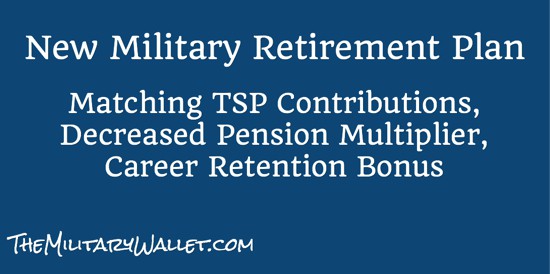The Blended Retirement System (BRS) is the new military retirement plan, which went into effect on January 1, 2018. The Senate Armed Services Committee passed the BRS as part of the FY 2016 National Defense Authorization Act (NDAA). The 2016 NDAA featured several major proposals, including military retirement reform, personnel reform, and headquarters and management reform.
One of the primary goals of the 2016 NDAA was to find areas for the Department of Defense (DoD) to save money. This came in many shapes and sizes, including reducing troop numbers, retiring old weapon systems, reducing the acquisitions of new weapon systems, and much more. Perhaps the biggest change happened to the military retirement system, which had seen few changes in the previous 70 years.
Servicemembers who had already retired, and those who joined the military prior to January 1, 2018, were grandfathered into the current military retirement systems (either High Pay, High-3, or REDUX).
That said, certain current servicemembers who had less than a given service time were allowed to opt into the Blended Retirement System. (see the section below for BRS eligibility).
We’ll give a brief overview of the current military systems, highlight why the government opted to enact the new Blended Retirement System, how the BRS works, whether or not members should opt into the BRS (if eligible), and how the BRS will impact current or future military retirees.
Note: the focus of this article is entirely on the defined benefit (pension) portion of military retirement benefits. The recent proposal didn’t include any major changes to other military retirement benefits, such as healthcare.
Table of Contents
- Military Retirement System Overview
- Why Did the Government Create the Blended Retirement System?
- Very Few Military Members Receive any Retirement Benefits
- Solution – Create Retirement Benefits Available to All Military Members
- Blended Retirement System Eligibility
- Active Duty Eligibility
- Guard / Reserve Blended Retirement System Eligibility
- Service Academy Eligibility for Cadets and Midshipmen
- How the Blended Retirement System Works:
- Matching Thrift Savings Plan Contribution Eligibility
- How Automatic and Matching TSP Contributions Work
- Continuation Pay Bonus
- Defined Benefit Changes (Changes to the Pension Portion)
- Lump Sum Option – Control Over How & When Retirement Pay is Received
- Opting Into the Blended Retirement System
- Pros and Cons of the Blended Retirement System
- Who Wins, and Who Loses?
Military Retirement System Overview
The current military retirement system is a “cliff-vesting” retirement plan, which basically means it’s all or nothing. Once you reach the required 20 years of service, you qualify for the entire retirement plan. Failing to reach the required 20 years of service nets servicemembers zero retirement benefits (except for early military retirees and medical retirees, which is out of the scope of this article).
Here is a basic overview of the military retirement pension plans available before the creation of the BRS:
- High Pay
- High-3 (average of highest three years of pay)
- REDUX (reduced multiplier in exchange for a Career Status Bonus of $30,000 cash at the 15-year mark).
These three systems all reward retirees with an immediate pension once they reach 20 full years of service. The High Pay and High-3 Systems give retirees a pension based on 2.5% of their base pay for each year they served on active duty. Under this plan, a 20-year retirement pension is worth 50% of the member’s base pay. There is also a Cost of Living Adjustment (COLA) each year based on the Consumer Price Index (CPI), the same measurement used for Social Security benefits and other government pensions.
The REDUX pension plan is slightly different. Retirees who choose this plan receive a $30,000 cash bonus at their 15-year mark in exchange for receiving a retirement multiple based on 2.0% of their base pay for each year served. Under this plan, a 20-year retirement pension is worth 40% of the member’s base pay. In addition, the annual COLA pay raise is based on CPI – 1. So if the CPI is 2.0%, REDUX retirees would only receive a 1% COLA increase. In general, REDUX is not a good deal for military members.
Here is a more in-depth analysis of active duty retirement benefits, including a podcast.
Why Did the Government Create the Blended Retirement System?
There were several reasons the DoD wanted to change the military retirement system. The annual fixed cost to the government is certainly a concern, as it is growing every year with more retirees and COLA increases.
But there is also a desire to make the military retirement system closer to what people might find in the civilian sector (except very few civilian companies offer pension plans these days). Many civilian employees have portable retirement plans they can take with them when they leave their job, often in the form of a 401k or similar retirement plan.
Very Few Military Members Receive any Retirement Benefits
Only about 17% of military members remain on active duty long enough to serve the full 20 years required to earn a military pension. That means roughly 83%, or about 5 out of every 6 servicemembers, don’t receive any long-term retirement benefit from their military service. Servicemembers do have access to the Thrift Savings Plan. However, they can only contribute funds from their own pay and bonuses. The military does not currently offer matching contributions like many civilian companies.
Solution – Create Retirement Benefits Available to All Military Members
The government changed the military retirement plan to provide service members with a 401k-style retirement plan (using the TSP) and a pension plan that vests at 20 years. Members are free to take their TSP account and matching contributions with them when they leave the military. This would come at the expense of a lower multiplier for the pension.
While the total fixed portion of the military retirement will be lower, it may actually be possible for servicemembers to have a larger total retirement package using the BRS, depending on how long they participate, whether they contribute bonus or other pay, and how well the stock markets perform.
Officials estimate that at least 75% of active duty servicemembers will receive some form of retirement benefits under the new plan, as opposed to the roughly 17% who receive benefits under the previous plans. The difference comes from the Thrift Savings Plan contributions made by the government, which would start after the servicemember has completed 2 years of service. Under this plan, the only servicemembers who wouldn’t receive some benefits would be those who serve fewer than 2 years.
Let’s look at Blended Retirement System eligibility and how the BRS works.
Blended Retirement System Eligibility
If you enter the Uniformed Services on or after Jan. 1, 2018, you are automatically enrolled in the BRS. This is your only retirement plan option. (This applies to the Active Component Service as well as the Reserve Component Services (National Guard and Reserves).
Active Duty Eligibility
Active Duty – More than 12 Years Service: If you are an Active Component Service member with 12 years (or more) of service prior to Dec. 31, 2017, you are grandfathered under the legacy retirement system (High Pay, High 3, or REDUX). You remain under the legacy retirement system, and nothing about your current retirement plan changes.
Active Duty – Less than 12 Years Service: If you are an active-duty Servicemember with fewer than 12 years of service as of Dec. 31, 2017, you are grandfathered under the legacy retirement system, but may choose to opt into the BRS. For most servicemembers, the opt-in period is from Jan. 1, 2018, through Dec. 31, 2018. You won’t be moved to BRS unless you make this choice.
Guard / Reserve Blended Retirement System Eligibility
Guard / Reserves – More than 4,320 Retirement Points: If you are in the National Guard or Reserves and have accrued more than 4,320 retirement points as of Dec. 31, 2017, you are grandfathered under the legacy retirement system. Nothing about your current retirement plan changes.
Guard / Reserves – Less than 4,320 Retirement Points: If you are a member of the National Guard or Reserve in a pay status who has accrued fewer than 4,320 retirement points as of Dec. 31, 2017, you are also grandfathered under the legacy retirement system, but may choose to opt into the BRS. Opting into the BRS does not change how you accrue retirement points or when you’re eligible to retire. You won’t be moved to BRS unless you make this choice.
Service Academy Eligibility for Cadets and Midshipmen
You’re also grandfathered under the legacy retirement system if you’re a cadet or midshipman attending a Service Academy as of Dec. 31, 2017, or are in the Reserve Officer Training Program with a signed contract as of Dec. 31, 2017.
However, if commissioning (or being placed in pay status) occurs after the 2018 opt-in window, you’ll have 30 days upon commissioning to opt into the BRS. If you enter an academy or sign your service contract on or after Jan. 1, 2018, your retirement plan is the BRS.

Check your VA Home Loan eligibility and get personalized rates. Answer a few questions and we'll connect you with a trusted VA lender to answer any questions you have about the VA loan program.
How the Blended Retirement System Works:
The Blended Retirement System utilizes the Thrift Savings Plan, a Career Continuation Bonus, and a pension. (This is the same plan proposed in the 2015 Military Compensation Modernization Recommendations.)
Here is an overview of how the Blended Retirement System works:
Matching Thrift Savings Plan Contribution Eligibility
All servicemembers who join the military after January 1, 2018, are automatically enrolled in the Thrift Savings Plan, with a default contribution rate of 3% of their base pay (or Inactive Duty Pay, or Drill Pay in the National Guard and Reserves).
Members will begin receiving an automatic contribution of 1% of their base pay from the DoD beginning 60 days after entering the military.
Members will begin receiving matching contributions up to an additional 4% of their pay (5% total) once they have completed two years of service (starting at 2 years, 1 day of service). The maximum DoD contribution is 5% if the service member is contributing 5% of their basic pay.
Both the DoD automatic 1 percent and the matching contributions continue through the end of the pay period during which the service member attains 26 years of service.
NOTE: Currently serving members who opt-into the BRS will receive automatic and matching contributions in their first pay period after opting in—there is no waiting period.
How Automatic and Matching TSP Contributions Work
The military automatic and matching TSP contributions will follow the same method the government uses for civilian TSP participants.
Members will receive the following matching contributions:
- automatic 1% contribution,
- a 1% matching contribution for each percent of their base pay the military member contributes for the first 3% of base pay,
- and a 0.5% matching contribution for each percentage the member contributes for the next 2 percentage points.
- The maximum DoD contribution is 5%.
This chart shows how this works in practice:
| You Contribute | Automatic 1% DoD Contribution | Service Matching Contribution | Total Combined Contribution |
|---|---|---|---|
| 0% | 1% | 0% | 1% |
| 1% | 1% | 1% | 3% |
| 2% | 1% | 2% | 5% |
| 3% | 1% | 3% | 7% |
| 4% | 1% | 3.5% | 8.5% |
| 5% | 1% | 4% | 10% |
| More than 5% | 1% | 4% | Your contribution plus 5% |
TSP Contribution Vesting:
Being vested means having ownership. You are always vested in (entitled to) your contributions and earnings.
If you opted into the BRS, you’re also immediately vested in the Service Matching Contributions and their earnings. To become vested in the Service Automatic (1%) Contribution, you must have completed two years of service. All Service members who have completed two years of service are considered fully vested.
Continuation Pay Bonus
Military members are eligible to receive a Continuation Pay Bonus if they re-enlist for during the Continuation Pay Bonus window. Each service can determine the specific reenlistment requirement, but it will be a minimum of 3 years (some services require 4 years).
The servicemember must have at least eight years of service but less than 12 years of service to be eligible for the Continuation Pay Bonus (service years are determined by the member’s Pay Entry Base Date).
How much is the Continuation Pay Bonus? Each Service determines and publishes its own guidance on continuation pay rates.
- Active Duty Continuation Pay Bonus is between 2.5x to 13x the member’s monthly base pay.
- Guard / Reserve Continuation Pay Bonus is between 0.5x to 6x the monthly basic pay of a member of the same pay grade, as if serving on active duty.
The multipliers are determined by each service based on their specific retention needs, specialty skills, and more. The Continuation Pay Bonus does not consider other reenlistment bonuses which may be in effect.
The servicemember could take the payment in a lump sum, or as annual payments during their reenlistment. Like all reenlistment bonuses, the Continuation Pay would be subject to being recouped if the servicemember failed to finish their enlistment (with limited exceptions).
Defined Benefit Changes (Changes to the Pension Portion)
The previous retirement plans are what most people think about when they think about the military retirement system. The rule of thumb most people use when thinking about the previous military retirement plans is 50% of base pay at 20 years of service.
This is shorthand for using a 2.5% multiplier for their retirement pay multiplier for each year of service. 20 years is the minimum requirement to reach retirement eligibility, which is why it is most frequently used. But you can serve over 20 years and you will still earn an additional 2.5% for each year served. So 20 years is 50%, 25 years is 62.5%, 30 years is 75%, etc.
The Blended Retirement System uses a 2.0% multiplier instead of a 2.5% multiplier, making a 20-year pension worth 40% of the retirement pay multiplier instead of the current 50%. 25 years would be 50%, 30 years would be 60%, etc.
When does retirement pay start?
There are no changes to the start date for retirement pay. Active duty members will receive their retirement pay starting the month after they retire from active duty. Members of the Guard or Reserves will receive their retirement pay at age 60 or earlier if they qualify based on active duty service mobilizations.
Lump Sum Option – Control Over How & When Retirement Pay is Received
Retirees under the Blended Retirement System can choose one of three methods for receiving their retirement benefits.
- No changes to how or when you receive benefits
- Receive 25% Lump Sum of the discounted present value of future retirement payments, in exchange for reduced monthly retired pay, until full Social Security retirement age, which for most is age 67.
- Receive 50% Lump Sum of the discounted present value of future retirement payments, in exchange for reduced monthly retired pay, until full Social Security retirement age, which for most is age 67.
Lump Sum Eligibility:
- Active duty: At retirement after 20 or more YOS.
- National Guard/Reserve: Upon becoming eligible to receive retired pay at age 60 (or earlier with creditable active service).
Lump Sum Election:
- Active duty: Lump sum election must be made no less than 90 days before retirement.
- National Guard/Reserve: No less than 90 days before receipt of retired pay.
How Much Does the Lump Sum option Cost?
When you take either 25 or 50 percent in a lump sum, your monthly paycheck will then be 75 or 50 percent of the full value of your monthly retired pay until you reach full Social Security age, which is age 67 for most individuals.
Is the Lump Sum Option Worth it?
This is a loaded question. The math almost never works in the favor of the retire. But there are times when retirees may need money up front, such as their military transition, starting a business, paying off debt, etc. This option adds flexibility, but also complexity when determining how much the retirement benefits are worth, and this complexity may end up hurting some retirees who end up making a poor decision based on their situation. On the flip side, having the option of taking a lump sum payment up front could help some retirees during their transition into the civilian sector.
This is a situation where it pays to run the numbers and fully understand how much taking the lump sum will cost (taxes, opportunity cost, decreased pension, etc.).
Opting Into the Blended Retirement System
Members who joined after January 1, 2018, are automatically enrolled in the BRS. This is their only option. And Active Duty service members with more than 12 years of service are ineligible to opt into the BRS. The same goes for National Guard and Reserve members with 4,320 retirement Points.
That leaves a large percentage of military members who are eligible to opt-into the BRS. You can do this quickly and easily through MyPay.
Note: The last day to opt into the BRS is December 31, 2018.
The question is, should you Opt-in to the BRS?
There is no right or wrong answer here. But as a general rule of thumb, if you are still young in your career and aren’t sure if you will remain on active duty long enough to earn a military retirement, then it makes sense to opt into the BRS. You will earn automatic contributions and matching contributions to the TSP. And you can take those with you when you leave the military if you decide to separate. That way you have some retirement benefits, even if you don’t earn the military pension. (Remember, over 80% of servicemembers don’t remain on duty until retirement).
The decision becomes more nuanced if you are further along in your career. At some point, you need to sit down and do some soul-searching regarding your career options, try to determine if you will stick around for at least 20 years of service, run some numbers, and make a decision.
Again there is no one-size-fits-all answer. I recommend reading this article on whether or not to opt into the Blended Retirement System. The article was written by a Certified Financial Planner who helps walk through a case study. It’s a great way to look at this from a big picture point of view.
Pros and Cons of the Blended Retirement System
In general, I’m not a fan when military benefits get reduced. Primarily because each reduction makes it easier to repeat in the future. But there is a lot to like here, particularly when it comes to helping the entire military population, not just the 1 in 6 who stay in long enough to retire. I don’t want to take anything away from anyone who served the full 20 years – I have a lot of respect for all of you!
But many served for 12, 14, 16, or 18 years and couldn’t complete the full 20. They are sent on their way with whatever they have in savings and whatever they could put into their TSP or their own investments. This Blended Retirement System gives members a greater incentive to save money in their TSP since the matching funds would equate to receiving free money. The Continuation Pay Bonus would also be an incentive to remain in the service and would be a nice bonus for those already planning on staying in the military.
Finally, the reduced pension isn’t a catastrophic reduction. Yes, 40% of your base pay is a lot less than 50%. Servicemembers who contribute enough to earn the 5% matching agency contributions will have saved at least 10% of their base pay throughout their careers. Depending on how the markets perform, the compounding effects of time may help erase the gap between the two pension plans.
Of course, that’s the big “what if”? We all know many people won’t save the full amount, even if they receive matching contributions, and we have no way of knowing what the markets will return. There is also a big difference between having a fixed pension for life and having some money in the bank that needs to be managed and withdrawn as needed (it’s more complicated due to the tax implications, the need to balance a portfolio, etc.).
Who Wins, and Who Loses?
The big winners would be the military members who serve a few years but don’t make it until retirement. They will have the opportunity to save some money for retirement and take it with them when they leave. And since that is the majority of the military population, there will be a lot of winners.
The government is also a winner, at least in some ways. They will save money on their fixed pension expenses, but much of those savings will be redirected to other servicemembers through the TSP and Continuation Pay Bonuses. Some retirees may also end up as winners, depending on how their investments do and how they take their pension payments.
The losers? I hate to use that term here because everyone currently in the previous system is grandfathered in. So the only people who will be affected are those who haven’t joined yet or those who elect to transfer into this system. I don’t want to discount our future servicemembers because they will carry on the traditions and defense of our nation. But they will join the military with that plan in place, so they aren’t losing out – they will receive what they signed up to receive.
The biggest question mark around this new plan surrounds the variable nature of the benefit. Trading a fixed monthly payment for a lower fixed payment and some money in your Thrift Savings Plan is risky because we can’t predict future returns. It’s impossible to accurately calculate the future value of this plan compared to the current plan. But that is a problem faced by the vast majority of the population and certainly not unique to military members.
Learn more: Visit the BRS Guide for more info.




Comments:
About the comments on this site:
These responses are not provided or commissioned by the bank advertiser. Responses have not been reviewed, approved or otherwise endorsed by the bank advertiser. It is not the bank advertiser’s responsibility to ensure all posts and/or questions are answered.
Brian Starr says
My other question was what enlisted traditional reservist that does 12 drills and 15 days of annual tour could possibly contribute $18,500 a year when they don’t make that in a year?